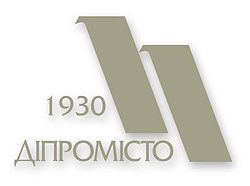Formation September 12, 1930 Founded 12 September 1930 | Website www.dipromisto.gov.ua | |
 | ||
Location Boulevard Lesi Ukrainky, 26, Kyiv, 01133, Ukraine Director Ivan Shpylevskyi, Honoured Architect of Ukraine | ||
Dipromisto (Ukrainian: Діпромісто), known in Russian as Giprograd (Гипроград), is a government-run research and urban planning institute in Ukraine. It was established on September 12, 1930, and is now part of the Ministry of Regional Development. Its full name is the Ukrainian State Scientific-Research Institute of Urban Design.
Contents
Under the Soviet Union, it was a system of planning institutes, consisting of a central institute in Kiev and affiliates in various oblasts. Over time, most of the affiliates separated from the Dipromisto system. Currently, the institute has three affiliates, located in Ivano-Frankivsk, Rivne, and Volyn.
Soviet era (1930–91)
Dipromisto was established on September 12, 1930, and tasked with planning, designing residential and community buildings, and related scientific work in the Ukrainian Soviet Socialist Republic (Ukrainian SSR). Before World War II, it focused on projects in major industrial regions: allocating resources for new development; planning cities and villages; designing community facilities and residential buildings; overseeing construction; and conducting research on spatial and urban planning.
From 1943–44, the main task of the institute was to identify the damage the war had done to urban economies and to set priorities in the effort to help Ukrainian cities recover. The enormous destruction demanded not only broad planning measures, but also new approaches to solving urban planning problems.
In the 1950s, planners' attention turned to the improvement and beautification of cities and villages, both in landscape and in architecture. In 1962, an architectural planning workshop was created to focus on resort and recreational development, and in the 1960 and '70s, a landscape workshop was formed.
The institute's regional planning work for the 25 oblasts of the Ukrainian SSR lasted from the late 1960s until 1989. In 1985, the institute started working on a "Summary Scheme of Regional Planning", which included analysis of territorial resources, the environment, and infrastructure.
Post-Soviet era (1991–present)
When Ukraine became an independent nation in 1991, Dipromisto was tasked with re-evaluating the development needs of the country and its regions, setting development priorities, reorganising Ukraine's settlement system in light of political and economic changes, and providing an integrated intrastate system for spatial and urban development.
Since then, the institute has incorporated geographic information systems (GIS) into its work. From 1991–93, its experts developed a system called MISTO. But by the end of 1995, it was evident that the institute's own software was insufficient for its tasks, and it began using products by Esri, a leading GIS software company. Such technological advancements allowed the institute not only to increase the quality of its spatial and urban planning, but also to rethink its methodology.
From 1993–2009, the institute was led by the architect Yurii Mykolaiovych Bilokon, who became a pioneer in the spatial planning of cross-border regions and established a methodological basis for such projects. Bilokon focused heavily on expanding the institute's scientific activities, educating the next generation of experts, and implementing new technologies. In collaboration with the Department of Urban Planning at the Kyiv National University of Construction and Architecture, he established a scientific and educational complex called Arhmistobud.
In 2009, the Ministry of Regional Development renamed the institute after Bilokon.
Mission
The responsibilities of Dipromisto include:
On May 3, 2012, the Ministry of Regional Development designated Dipromisto as a base organisation on scientific and technical activities in construction. This means the institute is entrusted with scientific, research, methodological, and information support functions in the planning and development of Ukrainian territories and settlements.
Works
Among other things, Dipromisto has worked on:
The institute has also helped with the reconstruction of the National Opera of Ukraine, the Odessa Opera and Ballet Theater, and the Expocentre of Ukraine. Other buildings it has worked on include the State Tax Inspectorate of the Pechersk Raion of Kiev; Kyiv National Linguistic University; the Kiev Academic Puppet Theatre; the Belarusian Embassy; and the National Academy of State Tax Service of Ukraine, in Irpin.
